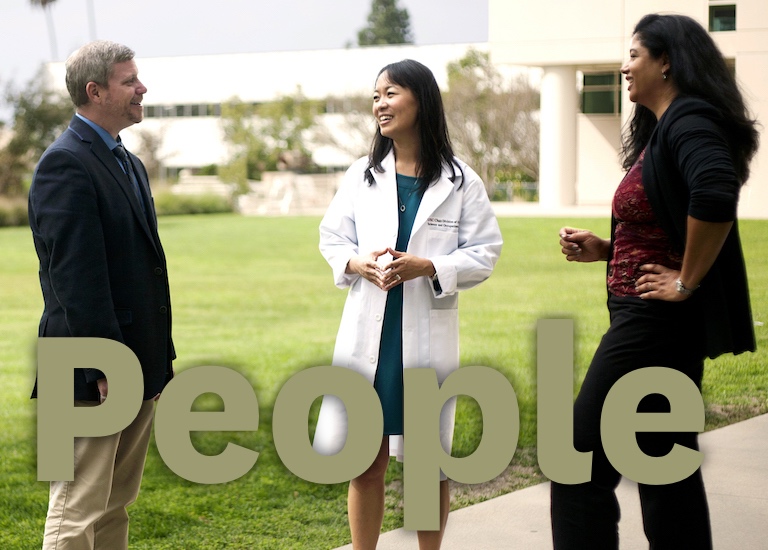Student Blog
Getting Involved
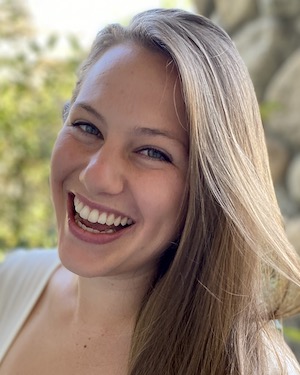
What Student Organization Should I Join? ⟩
August 4, 2020, by Savi
Getting Involved
As the summer semester is coming to an end and the fall semester is quickly approaching, many students become aware of the various opportunities they have to get involved. Emails start to trickle in informing them of volunteer opportunities, student organizations, student council, student worker positions, and much more. Looking back on my first year, I recall this being one of the most overwhelming times for me because I didn’t know which organization would be the best fit for me. For that reason, I have gone ahead and reached out to individuals in our program who are involved in each organization. I asked them why they chose to be a part of this organization and what they have gained from or learned about by being a member. Hopefully, this helps you decide what you want to be a part of!
I do want to echo Calvin, Lamoni, and Marilyn’s blog posts by reminding you all that it is ok to say no and that it is important to maintain a proper work-life balance. You do not have to be a part of multiple or any organizations for that matter! I urge you to invest time in things that matter to you. For the first three semesters of graduate school, I only committed my time to schoolwork and my job as a gym receptionist. It wasn’t until the Student Ambassador position presented itself at the end of my Spring semester that I found myself getting more involved in the Chan community outside of class. Whether your meaningful occupations fall within or outside our program, find one or two activities or organizations that you are passionate about. Try your best not to overcommit yourself and do not feel like you have to rush into a decision. If you are unsure about an opportunity I can promise you that a new one will be just around the corner! With that being said . . . here are students’ insight on their student organizations.
- OTs for OuTreach: “I chose to get involved with OTs for OuTreach because I wanted to be able to connect with other people in the program that aligned with my queer identity and be able to talk about our shared experiences throughout the program together. I was really searching for a sense of community and also a way I could get involved with the LGBTQ+ community in Los Angeles through community services/volunteer opportunities. I have always been involved in some way with queer organizations in high school and in undergrad so having a queer org in graduate school was essential for me to find community at the start of a new chapter in my life.” — Gabe Cravens; President of OTs for OuTreach
- Coalition of Occupational Therapy Advocates for Diversity (COTAD): “My COTAD team knows about the importance of representation. Many people do not apply to programs like ours because they don’t see anyone like them. And a lot of people don’t know about occupational therapy because it’s mainly a white, female, heterosexual, middle-class profession. So, establishing a COTAD chapter at USC felt really important (I think every OT program should have a chapter). Along with those points, the OS seminar has really emphasized cultural values and how that shapes people’s occupations. COTAD can bring more insight into those views by advocating for diversity. Taking on the role of chapter president made me nervous because of the time commitment but so many people have reached out saying that they want to get more involved, they’ve pitched in ideas on what our chapter should do, helped plan events. It truly ends up being a team effort. Because of that, Its a lot less overwhelming than I thought it would be. And we’ve only been established for a few months. We’re coming off the ground (which is the hardest part) so I can’t wait until the future when everything is rolling.” — Lamoni Lucas; COTAD Chair
- USC Occupational Therapy and Science Council (OTSC): “Being a part of OTSC has taught me how important it is to listen to the student body’s values and what they truly want from a governing student council, being the social media chair has taught me how important connection is, especially during this global pandemic in which we are all undergoing remote learning and our connections are no longer in person. We have been able to create a strong virtual bond regardless of external factors we have no control over, and that is why I decided to join OTSC, to connect and create the best graduate experience possible for all students!” — Samantha Coelho; OTSC Social Media Representative
- Pi Theta Epsilon (PTE): “I was interested in PTE because it was different from other organizations. PTE has a major focus on scholarship and research opportunities. As a research assistant, I have learned more about all of the cool things OS and OT research labs are working on, so I wanted to get involved in an organization that focused on conversations surrounding these topics. As a PTE member, I can utilize the division’s expansive resources to learn from a variety of Chan faulty and staff. Although we aren’t following the regular events we usually put on due to COVID-19 restrictions, we are taking more time to implement interdisciplinary programming with students in other health disciplines. We have developed an OT and PT forum to talk about case studies and build treatment plans together, and we are also adapting events to work with other PTE chapters. This organization takes its own spin on promoting scholarship and fostering opportunities to work in transdisciplinary teams.” — Renee Reinberg; Co-President of PTE
- USC Student-Run Clinic (SRC): “Before coming into OT school, I worked in an interdisciplinary clinic for children who’ve experienced trauma. I shadowed an OT and observed how she worked alongside a team of health professionals to tackle very complex situations. When I came into USC, I was very excited to be a part of the SRC, where different disciplines could also come together to work on healthcare cases for vulnerable populations. Being in SRC challenged my assumptions of other health professions and brought me more understanding of the unique role that each healthcare member contributes to the team. This experience also helped me feel more comfortable advocating for the importance of OT, both with clients and with other health professionals, as a means to serve complex populations more effectively as a team.” — Katherine Tao; JWCH Clinic Site Coordinator
- The Chan Community Commission (CCC): “Joining CCC was kind of serendipitous because my friend Sarah Morris and I wanted to create a peer mentorship program for incoming students during summer. We reached out to Dr. Rafeedie with the idea and were added to the taskforce that ended up evolving into the CCC! I have definitely enjoyed working together with such wonderful passionate people to make CCC a reality and share ideas and bring them to fruition.” — Kayla Jahari; Co-Leader of the Peer Mentorship Circles in CCC
- The Chan Community Commission (CCC) Continued:“For me, being a member of the Chan Community Commission (CCC) this summer has been a wellspring of hope and positive energy in the midst of the most tumultuous socio-political period of my life. I am grateful for the opportunity to collaborate with the CCC team to create opportunities for Chan students and faculty to build community and practice wellness together. I am looking forward to continuing to strengthen our OT community this fall as part of the OTSC Philanthropy Committee!”
— Adam Strizich; CCC Health & Wellness Sub-Committee Lead
**As Adam has mentioned the CCC will no longer continue under this title in the Fall, so please click here to learn more about the future of CCC and how they are uniting with OTSC and Global Initiatives.
⋯
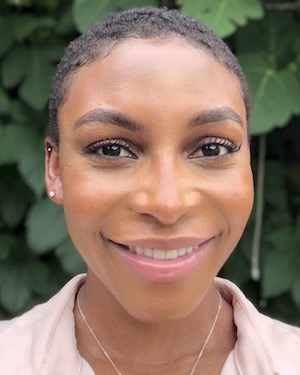
Student-Work-Life Balance ⟩
July 30, 2020, by Lamoni
Classes Getting Involved Life Hacks
We often hear about the importance of a work-life balance or a student-life and social-life balance. However, we do not talk much about the balance of being a student, being an employee, and being social or engaging in self-care. When I discuss work, I do not mean students that have student jobs (like me). Though that is also something to consider. Being a student with a student job still requires balancing but student jobs understand that your life as a student comes first. These jobs often allow time for studying while at work. They also tend to be more flexible to a student’s schedule. My boss constantly emphasizes self-care and she consistently remind my coworkers and I to adjust our schedules as needed. Shout-out to her; we love you Kim. The flexibility that I see in my job as a student worker typically does not ring true for employment outside of the university. Most employers expect their employees to be committed to a certain schedule and to give their full attention to their work while they are on the clock.
Recently, a few first-year students told me that they would like to become more involved but feel too busy with summer courses at the moment. Some even asked for advice on what they should do because they assumed that their lack of involvement would reflect poorly on them. I want to assure everyone that you are not obligated to join any organizations. Please do not overwhelm yourselves. In fact, many people do not become involved until their spring semester. The goal of the student-organization fair and any emails that you are receiving from organizations are to make you aware of what is out there. Think of them as saying “here are your options, if you so choose” and not “pick me!” If your plate is full or you simply are not interested right now, that is completely fine.
I brought up these concerns with my friend, Daphne, and they spoke about their own experience during their first semester of the master’s program (which we all know is very fast paced). But more than student life which includes student organizations and groups, they told me about how difficult it was to also have a job. After being in class from 8:30AM to 4:30PM, Daphne would go to work. Then after work, they would tend to homework and studying. They said “during summer, it was easy to be overwhelmed with everything going on. There were so many extracurriculars that I was I was interested in, but I did not have time between class and work. I hardly had time for sleep.” Daphne also mentioned feeling alone and unaware of any other students balancing jobs on top of their studies.
Now, with campus being closed due to COVID-19 and many student jobs being unavailable, I believe some students have picked up work outside of school. Additionally, I know that some students have children or are responsible for financially contributing to their household – maybe more so because of the pandemic. I have heard from some of my peers that their families are requiring more financial assistance from them. It is difficult to balance student-life, work-life, and life-life. Add in COVID-19 and it can become an even greater struggle.
So, what do you do?
If you can say “no,” say it.
I know that some responsibilities are non-negotiable. However, not everything requires your time. When someone asks something of you, the answer “no” is a viable option. For the people that have a hard time saying no, there are several ways to say it ~nicely~
Special shoutout to @BRIARAMs on twitter for creating a thread. Here are some of her suggestions.
“I appreciate you for considering me, but this is not for me at the moment.”
“I am unsure, may we revisit this another time?”
“Thank you so much for thinking of me, but I have committed to something else.”
“Unfortunately, now is not a good time.”
I used to have difficulty telling people no but there are only so many hours in a day. Plus, I cannot get the job done effectively If I am tired or have to tend to 100 things at once. Learning how to say no to some things allows you to say yes to what is important to you.
Reduce your involvement
Sometimes we get excited and push ourselves to become more involved than necessary. Similar to saying no, reducing your involvement helps to take some things off of your plate. As mentioned, many of you want to become more involved but you are concerned about the commitment. If there is something that you absolutely want to be a part of, become a member. But remember—That does not mean you have to be a board member. You do not have to show up to every meeting. You do not have to take on additional roles. Do what you can and nothing more.
When assistance is offered, take it
During these uncertain times, there are programs, loans, and grants to alleviate stress (e.g., CARES Act Federal Grant, housing/rent assistance, business loans). Take advantage of those modes of assistance. Their sole purpose is to offer help so do not feel bad. Apply for what you need. If you need them all, apply for them all.
Ask for help
When help is offered, we are more likely to take it than to directly ask for it. A lot of people struggle with asking for help. But honestly, there is no harm in it. The worst thing that can happen is being told no. Do you foresee yourself needing an extension on your paper? Ask for it. Ask your boss if you can do readings at work when things are moving slow. Many people are more understanding than we think. If you explain your situation, they may be willing to help you out.
I wish life was as simple as saying – just be a student and fully commit to that. But in reality, there are bills, there are student loans, there are car payments. There are responsibilities outside of being a student. However, there are a few things that you can do to make it all feel a bit more manageable. I hope these tips offer some relief.
⋯
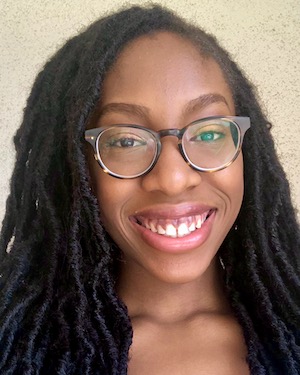
My Freshman Year Experience at USC ⟩
July 1, 2020, by Nmachi
Getting Involved
As of May 2020, I officially completed my first year at USC! I can truly say that the past year of living on campus has taught me a variety of things- positive and negative. My time as a freshman was so impactful for so many reasons. For one, I was able to meet and interact with people who would soon become like family, I achieved a new level of independence that I never had before, and I started the process of frequent inward thinking and learning more about who I am as an individual and what I desire to become.
I feel like the best place to start when discussing the highlights of my freshman year experience would be the place I called home on campus: Somerville Place. Somerville is a special-interest floor in the dorm building Fluor Tower (main campus); the floor houses freshmen who identify as Black and creates a safe space for them to bond and create lasting relationships. Applying to live on Somerville was, hands-down, the best decision I made during my senior year of high school (aside from applying to USC of course!). Since being involved in the Black community on campus is very important to me, I knew that I needed to put myself in the position to engage with my community everyday. Living with the students I met on Somerville was so fulfilling and freeing because I never had to worry about conforming or changing who I was in any way; I could just be my truest self.
Another highlight from my experience on campus would have to be the overall fun that comes along with attending a school like USC. Going to tailgates and Saturday football games with friends was an experience that I plan to continue to cherish through my career at USC.
On a more academic note, I definitely learned a lot from my experiences with classes. Registering for classes and deciding what you would be interested in was a process that I had to get used to. In terms of attending classes and workload, I think that I was fairly prepared because of how my high school instructed their curriculum. Despite having great preparation, I still found myself struggling with balancing academics and social life, especially because I was literally living with all of my friends on one floor. As time went on throughout both semesters, I began to create my own method of balancing everything in my life in a healthy way.
To all of those who might be seniors in high school and are wondering how life as a college freshman will be, I want to make it clear that every single person will have a different experience. My biggest recommendation is to make the most out of your time as a freshman. Freshman year is the time to discover things that make you happy and that you may want to pursue alongside your career. Make sure to try new things because you’ll probably pick up new hobbies and passions by doing so. Last but not least, take care of yourself by whatever means necessary. As a perfectionist, I tend to stress myself out with getting the best grades and accomplishing the most that I can. It is great to have a drive and to desire success, but it is just as crucial (or even more so) to focus on your physical and mental health.
With that being said, I am beyond grateful to have had the freshman year experience that I did, and am very excited to continue my journey at USC. Fight on! <3
⋯
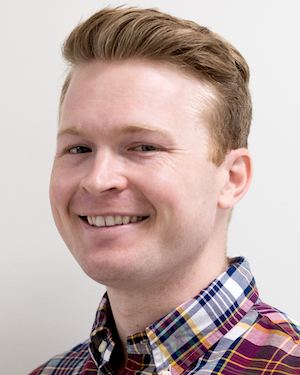
Advice for Incoming Master’s Students ⟩
April 28, 2020, by Kevin
Getting Involved Life Hacks
Congratulations, you are officially a Trojan or Double Trojan! You have just made one of the best decisions of your life to pursue a master’s degree in occupational therapy from the USC Chan Division! I have no regrets making that same decision two years ago and I cannot wait to continue with USC in the OTD program. This is my last blog as a student ambassador, and I wanted to end this time by passing on some of the lessons I learned during my time in the master’s program. Here are my top three pieces of advice:
Make Time for Fun, Friends, and Family
While the master’s program is not simple walk in the park, it should not feel like a walk through the haunted woods. You are a dedicated student and you deserve to take a breath and relax from time-to-time. Make it a priority to have at least one small, fun or social activity to look forward to each day. Once I start incorporating leisure and family time into my daily schedule, I found myself with little stress and my attention to coursework improved.
Reach Out to USC Faculty, Staff, and Students
The Trojan Family is not just a saying! The faculty, staff, and students at USC will be there for you whenever you need them, all you need to do is reach out. Even if it is not related to the program, there is always someone willing to provide you help or guidance for anything you may need. Specifically, the faculty and staff in the Chan Division have been incredibly supportive and approachable throughout my master’s program. Even now during this time at home, USC faculty members are willing to meet with students individually to discuss their goals and wellbeing. Just as I recommend reaching out to your friends and family, do not forget to make time for your Trojan Family!
Say Yes and Take Advantage of Opportunities in the Master’s Program
The Chan Division will introduce you to many new and exciting opportunities in the field of occupational therapy and beyond. From guest lectures, to innovation bootcamps, to volunteer events, find what interest you and utilize the opportunities the Chan Division has to offer. Additionally, when an opportunity comes along that you were not expecting, adventure out and say “yes”! You may discover a new practice field, a new interest, or a new friend.
These are my top three pieces of advice coming into this program. While studying is also important, I feel it was these three things that made my experience in the master’s program as amazing as it was. After building my foundation of support and taking new opportunities, I found that the studying came easy and my coursework had more meaning. Congratulations again on embarking on what will likely be one of the most transformative and positive experiences of your life! Fight on!
⋯

ASBME Makeathon: USC interdisciplinary collaboration ⟩
February 13, 2020, by Kevin
Externships Getting Involved
This past weekend, I had the opportunity to attend the Associated Students of Biomedical Engineering (ASBME) Makeathon event as an occupational therapy mentor. The Makeathon is an energy-charge 30 hour hackathon event in which 12 teams compete to develop and prototype a medical device for a selected real-world population. Using a combination of programing, CAD design, and access to the USC fabrication lab, including the 3D printers, each team rapidly develops an innovative medical or therapeutic technology. A Makeathon or hackathon challenges teams to produce months worth of work in just several days, in addition to having the material constraint of using only the materials provided by ASBME. While this event is primarily for students in the USC Viterbi Biomedical Engineering program, the organizers took an interdisciplinary approach by incorporating mentors from the master’s and doctorate programs of the Chan Division of Occupational Science and Occupational Therapy and the Division of Biokinesiology and Physical Therapy.
This year, the teams were challenged to develop a rehabilitation device that promoted or enhanced physical therapy activity in a nonclinical setting for persons who are experiencing hand or wrist dysfunction post-stroke. Additionally, the device had to be intuitive and address one aspect of motor control including strength, dexterity, and joint extension. Due to my background in 3D modeling and education in occupational therapy, I jumped on the opportunity to take part in the Makeathon as a mentor for the teams.
From the perspective of occupational therapy, the OT students were able to provide valuable advice and suggestions to each team considering person, environment, and occupational of the potential user. During my mentorship time, I performed role plays to help the teams imagine the device in everyday use, provided anatomical explanations pertaining to post-stroke hand and wrist considerations, and advised on design aspects. The undergraduate biomedical engineering students were incredible! I’ve never seen such fast CAD design or Arduino programming. While the students were working furiously to produce their device, they took time to seek out the mentorship of the OT and PT students, which helped the teams understand the rehabilitation applications of their designs. Everything from electronic glove games to dexterity puzzles were made during the course of the competition.
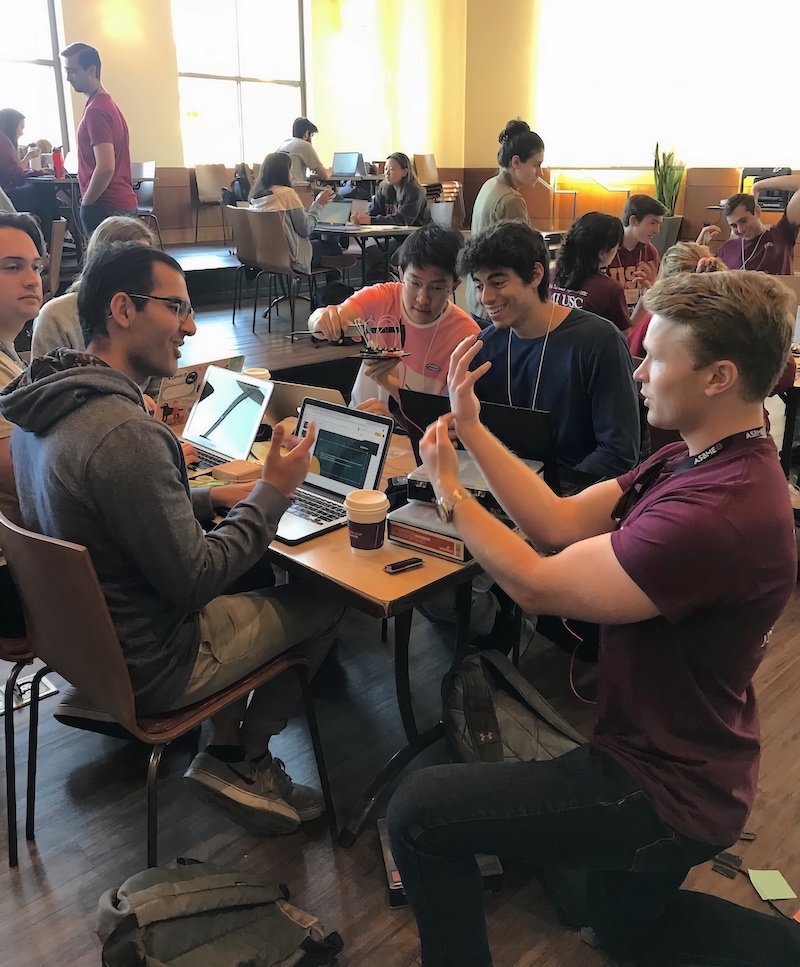
Explaining the extensor anatomy of the wrist and hand during mentorship.
Overall, it was amazing to see biomedical engineering, physical therapy, and occupational therapy students collaborating effectively to inspire truly creative innovation. Attending this event was a subtle reminder to the amazing minds and talent of the students at USC!
⋯





